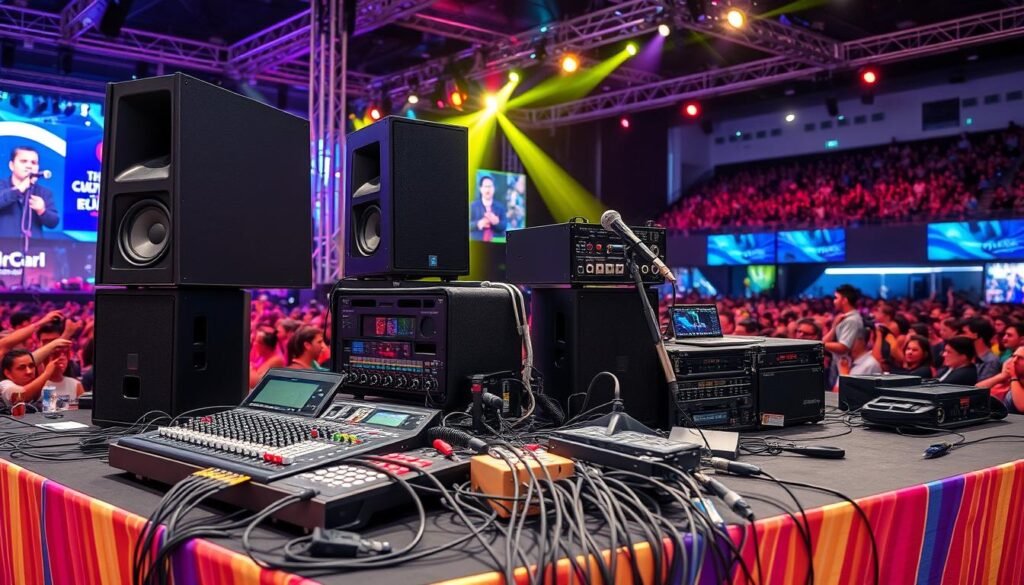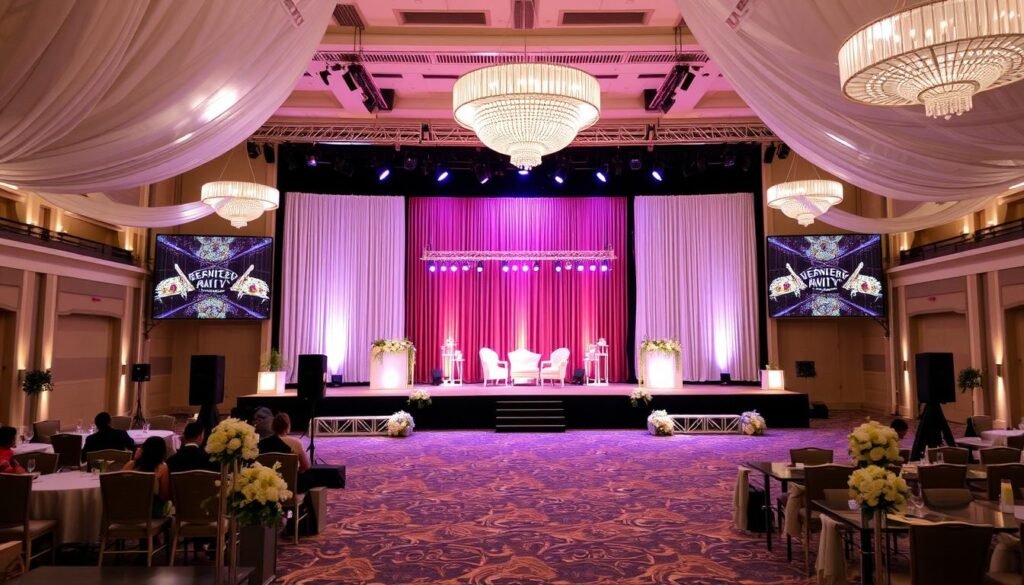פתרונות תצוגת אירועים חיוניים לאירוח אירועים בלתי נשכחים. הם משפרים כנסים תעשייתיים, חתונות ופסטיבלי מוזיקה. הפקת אירועים מקצועית משתמשת בציוד אודיו ויזואלי ובעיצוב במה יצירתי כדי לשפר את האווירה.
התצוגה היעילה מעלה את ההצלחה של האירוע שלך ומשאירה רושם שיותר. היא עוזרת להשיג את המטרות שלך ולשקוף את הקהל שלך. על ידי עבודה עם מומחים, תוכל ליצור חוויית טבילה.
הרכיבים הנכונים לתצוגה מגבירים את האירוע שלך. הם יוצרים אווירה ייחודית שהמשתתפים יזכרו. עם תכנון נכון, תוכל להעביר את ההודעה שלך בצורה אפקטיבית ולעסוק את הקהל שלך.
מסקנות מרכזיות
- פתרונות תצוגת אירועים הם חיוניים ליצירת חוויה זכורה ומשפיעה למשתתפים
- הפקת אירועים מקצועית כוללת את השימוש בציוד אודיו ויזואלי, תאורה ורכיבי עיצוב במה
- תכנון וביצוע תצוגת האירוע יכולים להשפיע באופן משמעותי על ההצלחה של אירוע
- לשפר את הידע של מומחים בהפקת אירועים יכול לעזור ליצור חוויית צפייה עמוקה עבור המשתתפים
- לשלב את הרכיבים הנכונים של הבמה יכול להבדיל את האירוע שלך ולהשאיר רושם אינפורמטיבי על הקהל שלך
הבנת חשיבות ההפקה של אירועים
ההפקה של אירועים היא מרכזית ליצירת אירועים מוצלחים. היא כוללת את החלקים הוויזואליים של האירוע, כמו עיצוב במה ותאורה. ההפקה הטובה יכולה ליצור רושם שיישאר אצל המשתתפים לאורך זמן.
ההפקה עוזרת למארגנים ליצור חוויית צפייה עמוקה. היא יכולה לעזור להם להשיג את מטרות האירוע שלהם. עם ההפקה הנכונה, המשתתפים יזכרו באירוע לאחר שהוא נגמר.
יצירת חוויית צפייה נצחית עבור המשתתפים
המטרה של ההפקה של אירועים היא ליצור רגעים בלתי נשכחים עבור האורחים. השילוב הנכון של אורות, צלילים וויזואלים יכול להעביר את המשתתפים לעולם אחר. ההפקה המוטבעת זו שומרת על מעורבות האנשים לאורך כל האירוע.
ההפקה הטובה מושכת לרבים מהחושים. היא משתמשת בתאורה דינמית, צליל איכותי וגרפיקה מרהיבה. הגישה הזו של מרבית החושים משאירה רושם שיישאר אצל המשתתפים.
חוויית אירוע נצחית עשויה להוביל לשיווק פה-לפה חיובי. המשתתפים המרוצים יותר סביר שיחליפו את חוויותיהם עם אחרים. זה עשוי לסייע בקידום אירועים עתידיים.
שיפור המיתוג וההודעות של האירוע
הסטייג'ינג של האירוע מחזק את המיתוג וההודעות. זה משתמש בצבעי האירוע, לוגואים והודעות מרכזיות בעיצוב הבמה. המיתוג העקבי הזה יוצר תמונה מקצועית ומגביר מודעות למותג.
הסטייג'ינג היעיל עוזר לתקשר הודעות מרכזיות באופן ברור. עזרי חזות כמו מסכי הצגה עושים את המידע קל להבנה. זה מוביל להשתתפות גבוהה יותר של המשתתפים ולהבנה טובה יותר של מטרות האירוע.
"הסטייג'ינג של האירוע אינו רק על יצירת הגדרה חזותית מרהיבה; זה על יצירת חווית טמע שמעוררת את המשתתפים ומשאירה רושם של זמן רב." – סרה תומפסון, מנהלת הפקת אירועים בחברת Encore Event Technologies
הצגת אירועים ברמה גבוהה יכולה לשפר את ההחזר על ההשקעה (ROI) של האירוע. זה יוצר חוויות זכורות שמעודדות את המשתתפים לחזור. זה עשוי להביא למכירת כרטיסים גבוהה יותר ולהזדמנויות תמיכה נוספות.
משתתפים מרוצים יותר יותר אפשרות שימליצו על האירוע לאחרים. הנאמנות המוגברת הזו עשויה להביא להכנסה כללית גבוהה יותר מהאירוע.
| רכיבי תצוגת האירוע | השפעה על חוויית המשתתפים | תרומה לתשואת האירוע |
|---|---|---|
| תאורה אימרסיבית | יוצרת אווירה מרתקת | מגבירה השתתפות של המשתתפים ושביעות רצון |
| שמע באיכות גבוהה | מבטיח תקשורת ברורה ומשפיעה | משפר הבנה ושימור של המשתתפים |
| עיצוב במות ממותג | מחזק את המיתוג וההודעה של האירוע | מעלה מודעות למותג וזיהוי |
| קירות וידאו אינטראקטיביים | מעוררים את תשומת לב המשתתפים עם ויזואלים דינמיים | מגבירים את ההשתתפות והאינטראקציה של המשתתפים |
עיצוב אירועים הוא חיוני ליצירת אירועים משפיעים. זה יוצר חוויות שנשארות בזיכרון ומשפר את המיתוג. עיצוב טוב גם מקדם החזר על ההשקעה באירוע.
מארגנים אמורים לשקול את הגורמים הללו בתכנון העיצוב של האירוע שלהם. זה יעזור להם לקבל החלטות מושכלות וליצור אירועים מוצלחים.
סוגי ציוד לעיצוב אירועים
הציוד לעיצוב האירוע הוא חיוני להצלחת האירוע. כל אלמנט משפר את החוויה הכוללת של המשתתפים. בואו נגלה סוגים חיוניים של ציוד לעיצוב אירועים.
מערכות קול ומיקרופונים
מערכות קול איכותיות הן חיוניות לכל אירוע. הן מבטיחות שהמרצים ישמעו בבהירות בכל רחבי האולם. יש לשקול גורמים כמו גודל המרחב של האירוע ומספר המשתתפים בעת בחירת ציוד הקול.
מיקרופונים אלחוטיים מציעים גמישות למרצים. מיקרופונים לוואלייה עובדים טוב לדיוני פאנל וראיונות.

תאורה ואפקטים חזותיים
התאורה יכולה להפוך מרחב רגיל לסביבה מרתקת. תאורת LED פופולרית בגלל הגמישות והיעילות האנרגטית שלה. היא יוצרת סכמות צבע דינמיות שמשפרות את האווירה.
מכשירי ראש נעים ותאורה תכנותיים יוצרים תצוגות חזותיות מרהיבות. הם יכולים לסנכרן עם מוזיקה או להדגיש רגעים מרכזיים. גובוס מקרינים לוגואים או דפוסים, מוסיפים מגע אישי.
מסכי הקרנה וקירות וידאו
מסכי הקרנה וקירות וידאו הם חיוניים לעורר קהלים בצורה יעילה. הם מציגים הצגות וסרטים בבהירות ובהשפעה. לאירועים גדולים, ניתן להשתמש במספר מסכים או ליצור קיר וידאו.
תצוגות אינטראקטיביות מוסיפות שכבת מעורבות נוספת. מסכי מגע או מערכות מציאות מדומה יכולות לטבוע את המשתתפים בחוויה.
| סוג הציוד | יתרונות | מומלץ עבור |
|---|---|---|
| מיקרופונים אלחוטיים | גמישות וחופש תנועה עבור דוברים | דיבורי ראש, הרצאות והופעות |
| תאורת LED | יעילות אנרגטית, רב-תכליתי וניתן לתכנות | יצירת סביבות דינמיות ומובילות |
| הקרנת וידאו | תצוגות ברזולוציה גבוהה להרצאות וסרטים | כנסים, השקות מוצרים ואירועים חינוכיים |
| תצוגות אינטראקטיביות | חוויות מעוררות עניין ומובילות למשתתפים | תערוכות מסחר, תערוכות ואירועי שיווק חווייתיים |
בחרו בזהירות ושלבו את סוגי ציוד הבמה החיוניים הללו. הגישה הזו יוצרת חוויית צפייה מרהיבה. האירוע שלכם ישאיר רושם אינסופי על המשתתפים.
עיצוב תכנית הבמה של האירוע שלכם
תכנית במה אפקטיבית היא חיונית לחוויה מוצלחת וזכורה. עיצוב הבמה צריך להיות מרהיב ופונקציונלי. צריך לאפשר מעברים חלקים והשתתפות מיטבית של הקהל.
שקלו את מטרת האירוע וגודל הקהל בעת עיצוב התכנית שלכם. תכנית רצפה מתוכננת היטב מספקת קווי ראייה ברורים לכל המשתתפים. היא מבטיחה שכולם יכולים לראות ולשמוע בקלות את הדוברים או הבמאים.
התכנית צריכה גם לקלט גישה קלה לאזורים מרכזיים. אלה כוללים את הבמה, המושבים וכל אלמנטים אינטראקטיביים.

שלב רעיונות יצירתיים לעיצוב במה כדי לשפר את חוויית הצפייה הכוללת. רעיונות כוללים רקעים ייחודיים בעיצוב נושא והגדרות מודולריות להגדרות גמישות. תכונות אינטראקטיביות כמו מסכי LED או קירות למדיה חברתית עשויים לעודד השתתפות הקהל.
- רקעים ייחודיים המשקפים את נושא האירוע או המיתוג
- הגדרות מודולריות שמאפשרות הגדרות גמישות ושינויים מהירים בין הסשנים
- תכונות אינטראקטיביות, כמו מסכי LED או קירות למדיה חברתית, לעידוד השתתפות הקהל
"פריסת במה מוצלחת צריכה להיות נאה מבחינה אסתטית ופונקציונלית ביותר, יוצרת סביבה טובלת שמשך את המשתתפים ומשאירה רושם שייך." – סרה תומפסון, מנהלת הפקת אירועים ב-Stellar Events
שקול את הגורמים הללו כדי לייעל השתתפות הקהל ולוודא זרימת האירוע חלקה:
| גורמים | שיקולים |
|---|---|
| קווי ראייה | ודא שיש תצפיות בלתי מפונקות לבמה מכל אזורי המושבים ומיקומי העמדה. |
| שמע ותאורה | תכנן את מיקום הרמקולים, המיקרופונים ותאורת התקרה כך שיספקו כיסוי אחיד וישפרו את חוויית הצפייה הכוללת. |
| נקודות כניסה ויציאה | עצב נקודות כניסה ויציאה ברורות ונגישות בקלות כדי להפחית סתירות ולוודא זרימה חלקה של המשתתפים. |
| רכיבים אינטראקטיביים | שלב תכונות מעניינות, כמו תיאטרונים צילום או תצוגות מוצרים, כדי לעודד השתתפות של המשתתפים וליצור רגעים נצחיים. |
פריסת במה לאירועים שמתוכננת בקפידה יוצרת סביבה מובילה ומעוררת השתתפות. היא משאירה רושם אינפורמטיבי על המשתתפים שלך. חשוב לשקול את כל הנקודות כדי להבטיח אירוע מוצלח ונצחי.
עבודה עם חברות תפעול מקצועיות לאירועים
חברות ייצור אירועים מביאות מומחיות וציוד ליצירת חוויות מובילות. הן משתמשות בהשכרת ציוד אודיו וויזואלי ובטכנולוגיה מתקדמת כדי לעצב התקנות מותאמות. הידע שלהן עוזר ליישר את ערכת האירוע שלך, המיתוג והמטרות בצורה מושלמת.
יתרונות של שכירת מומחי תפעול אירועים
מומחי תפעול מקצועיים מקסימיזים התקנות לשיפור השפעה מרבית. הם מניחים בצורה אסטרטגית תאורה, מערכות קול וויזואלים כדי ליצור אווירה מעוררת השתתפות. טכנאים מנוסים פותרים במהירות בעיות טכניות, מבטיחים אירוע חלק.
זה מאפשר לך להתמקד בהתקשרות עם המשתתפים ובניהול הלוגיסטיקה. המומחיות שלהם משחררת את הזמן שלך לנקודות אירוע קריטיות אחרות.
בחירת השותף לתפעול אירועים הנכון
בחרו בזהירות חברת תקנון אירועים עם רקורד מוכח. חפשו portofolio מגוון המציג יכולות בכל סוגי האירועים והגדלים. בדקו את המלאי שלהם של השכרת ציוד אודיו וויזואלי והיכרותם עם הטכנולוגיה האחרונה בתחום האירועים.
העריכו את שירות הלקוחות וכישורי התקשורת שלהם. שותף בתקנון אמין וזמין יכול להביא לשיפור משמעותי בהצלחת האירוע שלכם.
השתתפות עם מומחים מעלה את האירוע שלכם לגבהים חדשים. חברות תקנון מקצועיות מבטיחות חוויות סוחפות וביצוע טכני חלק. המומחיות שלהם עוזרת ליצור רושם שיישאר אצל המשתתפים שלכם.



